Report shows cow vigilantism isn't sporadic. Ultimate aim is Hindu Rashtra

The June 2017 Goa conclave of Hindutva organisations declared 2023 as the year to establish formal 'Hindu Rashtra'. Prime Minister Narendra Modi said that by 2022, a New India will be established. These are not unrelated. The year 2022 also would denote the centenary of the publication of Savarkar’s 'Hindutva- Hindurashtra' thesis.
This is one of the key conclusions drawn by a fact finding team that released a report 'Divide & Rule – In the name of Cow' on Wednesday at the national convention of Bhumi Adhikar Andolan, a coalition of social movements and peoples’ organisations formed in 2014 as a resistance to the land ordinance introduced by ruling government.
The report is a compilation of findings of a team of activists that had visited Bharatpur, Rajsamand, Alwar and Udaipur in Rajasthan in January this year to see the situation on the ground in context of the terror unleashed by the cow vigilantes. These districts have been the theatre of violence in the name of cow reporting some of the most horrifying lynchings and killings. The team that ad conducted field visits includes senior lawyers, representatives of farmers' organisations and social activists who have come come under the banner of Bhumi Adhikar Andolan.
They have concluded, “The Hindutva forces are zealously moving towards this set goal of Hindu Rashtra by artificially creating pan-Hindu political identity and 'cow protection' is one such identity creation. The identity creation by Hindutva forces is aimed only to further stabilise power by polarising the population by spreading hatred and nurturing distrust among themselves.”
In the context of Rajasthan, the report says that findings reveal there is total loss of faith in the law and order mechanism of the Bharatiya Janata Party (BJP) led state government. “It is a matter of grave concern that the main opposition party in the state, the Congress has failed to address the issue and mobilise opinion against the communal attacks on citizens. Unfortunately, they have made no efforts to reach out to the families of victims or those facing attacks or being arrested on false charges,” it reads.
It has been underlined that the continuous attacks on the minorities in the guise of cattle protection would divide the people on communal lines. If it is allowed to continue, the unity of the country in the long run will be in peril. “Hate crimes are violent manifestations of intolerance against entire communities. They have a deep impact not only on the immediate victim but also the community with which the victim identifies, affecting social cohesion and stability,” it says.
The investigators found that the victims and their families have been living in these villages for generations rearing cattle as their only livelihood. There hasn’t been any substantial change or transformation in their lifestyle, social involvement and transaction. But overnight their position in society and the communal harmony have been changed oppressively and turtle-turned on the inception of the new communal regime of 'fascist' tendencies.
“Then comes Gau Raksha vigilance and other Sangh Parivar outfits to polarise the society on religious and communal terms with hate crimes. Unfortunately the fact that there is no effective and specific law
against hate crimes and mob lynching compounds the situation,” the report says.
It points out that the vigor and nexus of cow vigilantism has increased with the ascendance of corporate supported BJP government into power at the center. Quoting 'India Spend', a data journalism website, the report says that 97 per cent of all cow vigilante attacks reported since 2010 took place after the 'Hindu nationalist' BJP came to power in 2014 with Modi as the prime minister. It reads in the preface that Muslims and Dalits have traditionally skinned the carcasses of cows and taken the dead bodies off the roads for decades, now they are selectively bullied, assaulted and lynched. About 25 of 29 persons who were lynched were Muslims. Of all victims, killed or injured, whose identities were reported in the media, 53 per cent were Muslim, 12 per cent were Dalit, and 10 per cent were Hindu.
“The most common factor among all the victims was that those killed by cow vigilantes were poor farmers. In a third of all the cases i.e. 26 of 78 cases the police filed counter cases against the victims
under cow protection laws. Among the 78 incidents reported, the number of total victims was 293 of which 29 were lynched and 50 out of these 78 incidents occurred in Northern India,” the report says.
It further says that despite this alarming rate of killings, the respective state governments as well as the
centre have failed to investigate the attacks in a credible fashion. That in many cases, instead of prosecuting the attackers (many of whom are allegedly linked to extremist Hindu groups affiliated with the ruling party) the police have filed complaints under laws banning cow slaughter against the assault victims, their relatives and associates.
“Because of this kind of implicit support to the attackers, the general trend is to trivialize the incident
increasing incidents of lynching and attacks in the name of 'Gau Raksha' (Cow Protection), encounter killings, deliberate communal polarization and attacks on Muslims in the state,” it says.
While releasing the report, it was demanded that the real culprits responsible for the murders in the name of cow vigilantism be arrested immediately and there be a judicial probe. It was sought that the government facilitate cattle trade and amend the Cow Protection Act to purchase unproductive animals by paying market rate to the owners besides banning cow vigilante organisations and enacting special and specific provisions in the under Indian Penal Code to prevent lynching.
“Although we investigated the situation in four districts of Rajasthan, the situation is pretty much the same in Haryana also,” says Mujahid Nafees, one of the members of the fact finding team.


